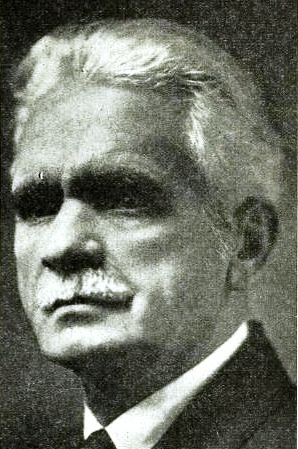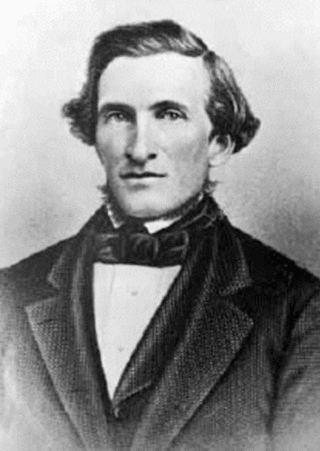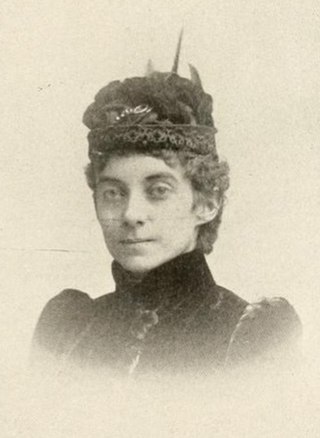Related Research Articles
The Mountain Meadows Massacre was a series of attacks during the Utah War that resulted in the mass murder of at least 120 members of the Baker–Fancher emigrant wagon train. The massacre occurred in the southern Utah Territory at Mountain Meadows, and was perpetrated by the Mormon settlers belonging to the Utah Territorial Militia who recruited and were aided by some Southern Paiute Native Americans. The wagon train, made up mostly of families from Arkansas, was bound for California, traveling on the Old Spanish Trail that passed through the Territory.
Within Mormonism, the priesthood authority to act in God's name was said by its founder, Joseph Smith, to have been removed from the primitive Christian church through a Great Apostasy, which Mormons believe occurred due to the deaths of the original apostles. Mormons maintain that this apostasy was prophesied of within the Bible to occur prior to the Second Coming of Jesus and was therefore in keeping with God's plan for mankind. Smith claimed that the priesthood authority was restored to him from angelic beings—John the Baptist and the apostles Peter, James, and John.

Brigham Henry Roberts was a historian, politician, and leader in the Church of Jesus Christ of Latter-day Saints. He edited the seven-volume History of the Church of Jesus Christ of Latter-day Saints and independently wrote the six-volume Comprehensive History of the Church of Jesus Christ of Latter-day Saints. Roberts also wrote Studies of the Book of Mormon—published posthumously—which discussed the validity of the Book of Mormon as an ancient record. Roberts was denied a seat as a member of United States Congress because of his practice of polygamy.

Jedediah Morgan Grant was a leader and an apostle of the Church of Jesus Christ of Latter-day Saints. He was member of the First Council of the Seventy from 1845 to 1854 and served in the First Presidency under church president Brigham Young from 1854 to 1856. He is known for his fiery speeches during the Reformation of 1856, earning the nickname "Brigham's Sledgehammer". Grant is the father of Heber J. Grant, who later served as President of the Church.
The Mormon blogosphere is a segment of the blogosphere focused on issues related to the Church of Jesus Christ of Latter-day Saints. The term "Bloggernacle" was coined by individuals within the Latter-day Saint blogging community as a play on the name of the Mormon Tabernacle Choir; however, not all Latter-day Saint-themed bloggers like or use the name Bloggernacle, or even consider their blog to be part of it. Furthermore, not all bloggers within the Mormon blogosphere are Latter-day Saints themselves.
Mormons have both used and been subjected to significant violence throughout much of the religion's history. In the early history of the United States, violence was used as a form of control. Mormons were violently persecuted and pushed from Ohio to Missouri, from Missouri to Illinois and from Illinois, they were pushed west to the Utah Territory. There were incidents of massacre, home burning and pillaging, followed by the death of their prophet, Joseph Smith. Smith died from multiple gunshot wounds from a lynch mob at a jail in Carthage, Illinois; Smith had defended himself with a small pistol smuggled to him by church leader Cyrus Wheelock and he was then shot while trying to flee from a window. There were also notable incidents in which Mormons perpetrated violence. Under the direction of Mormon prophets and apostles, the Mormon burned and looted Davies County, attacked and killed a member of the Missouri state militia, and carried out an extermination order on the Timpanogos. Other Mormon leaders led the Mountain Meadows Massacre, Battle Creek massacre, and Circleville Massacre. Mormons have also been a major part in several wars, including the 1838 Mormon War, Walker War and Black Hawk War.
The Mountain Meadows Massacre was caused in part by events relating to the Utah War, an armed confrontation in Utah Territory between the United States Army and Mormon Settlers. In the summer of 1857, however, Mormons experienced a wave of war hysteria, expecting an all-out invasion of apocalyptic significance. From July to September 1857, Mormon leaders prepared Mormons for a seven-year siege predicted by Brigham Young. Mormons were to stockpile grain, and were prevented from selling grain to emigrants for use as cattle feed. As far-off Mormon colonies retreated, Parowan and Cedar City became isolated and vulnerable outposts. Brigham Young sought to enlist the help of Indian tribes in fighting the "Americans", encouraging them to steal cattle from emigrant trains, and to join Mormons in fighting the approaching army.
Mormon theology has long been thought to be one of the causes of the Mountain Meadows Massacre. The victims of the massacre, known as the Baker–Fancher party, were passing through the Utah Territory to California in 1857. For the decade prior the emigrants' arrival, Utah Territory had existed as a theocracy led by Brigham Young. As part of Young's vision of a pre-millennial "Kingdom of God", Young established colonies along the California and Old Spanish Trails, where Mormon officials governed as leaders of church, state, and military. Two of the southernmost establishments were Parowan and Cedar City, led respectively by Stake Presidents William H. Dame and Isaac C. Haight. Haight and Dame were, in addition, the senior regional military leaders of the Mormon militia. During the period just before the massacre, known as the Mormon Reformation, Mormon teachings were dramatic and strident. The religion had undergone a period of intense persecution in the American mid-west.
The pursuit of the perpetrators of the Mountain Meadows massacre, which atrocity occurred September 11, 1857, had to await the conclusion of the American Civil War to begin in earnest.

Ronald Davis Bitton was a charter member and president of the Mormon History Association, professor of history at the University of Utah, and official Assistant Church Historian in the Church of Jesus Christ of Latter-day Saints working with Leonard J. Arrington.
Boyd Jay Petersen is program coordinator for Mormon Studies at Utah Valley University (UVU) and teaches English and literature at UVU and Brigham Young University (BYU). He has also been a biographer of Hugh Nibley, a candidate for the Utah House of Representatives, and president of the Association for Mormon Letters. He was named editor of Dialogue: A Journal of Mormon Thought for the term 2016-2020.
Richard Eyring "Rick" Turley Jr. is an American historian and genealogist. He previously served as both an Assistant Church Historian of the Church of Jesus Christ of Latter-day Saints and as managing director of the church's public affairs department.

Josephine Spencer was an American writer, journalist, and political activist from Utah. She was an important figure in the Mormon Home Literature movement of the late 19th century who published more than a hundred poems fifty short stories, and five serialized novels in both regional and national publications. Latter-day Saint literary critics Ardis E. Parshall and Michael Austin have called her "the most significant figure in Mormon letters that most people have never heard of."
In 1857, at the time of the Mountain Meadows Massacre, Brigham Young, was serving as President of the Church of Jesus Christ of Latter-day Saints and as Governor of Utah Territory. He was replaced as governor the following year by Alfred Cumming. Evidence as to whether or not Young ordered the attack on the migrant column is conflicted. Historians still debate the autonomy and precise roles of local Cedar City LDS Church officials in ordering the massacre and Young's concealing of evidence in its aftermath. Young's use of inflammatory and violent language in response to a federal expedition to the territory added to the tense atmosphere at the time of the attack. After the massacre, Young stated in public forums that God had taken vengeance on the Baker–Fancher party. It is unclear whether Young held this view because of a possible belief that this specific group posed a threat to colonists or that they were responsible for past crimes against Mormons. According to historian William P. MacKinnon, "After the war, Buchanan implied that face-to-face communications with Brigham Young might have averted the Utah War, and Young argued that a north–south telegraph line in Utah could have prevented the Mountain Meadows Massacre."
William P. MacKinnon, an American independent historian. A management consultant, MacKinnon is a historian of the American West, Mormon history, and Utah history who was described by Richard E. Turley in 2018 as "the acknowledged expert" and by Thomas G. Alexander in 2019 as "the most knowledgable authority" on what was known in its time as the American War of the Mormons' Succession, a topic of which MacKinnon began his study as a Yale sophomore history major in 1958. In 2018, MacKinnon presented the 35th Juanita Brooks Lecture at Dixie State University: "Across the Desert in 1858: Thomas L. Kane’s Mediating Mission and the Mormon Women who Made it Possible." As of 2010, MacKinnon lived in Santa Barbara with his wife, Patricia.

Mormonism: A Historical Encyclopedia is an encyclopedia designed for a general readership about topics relating to the History of The Church of Jesus Christ of Latter-day Saints, edited by W. Paul Reeve and Ardis E. Parshall. Reeve is a professor of history at the University of Utah and Parshall is an independent historian, newspaper columnist, and freelance researcher. Most of the encyclopedia's articles were written by historical researchers expert in the specific area covered, while the tone employed is one of objectiveness, yet respect for the beliefs of Mormonism and its culture. It is published by ABC-CLIO, a Santa Barbara, California-based publisher of reference works, as well as of the history journal, Journal of the West.
Mormon studies is the interdisciplinary academic study of the beliefs, practices, history and culture of individuals and denominations belonging to the Latter Day Saint movement, a religious movement associated with the Book of Mormon, though not all churches and members of the Latter Day Saint movement identify with the terms Mormon or Mormonism. Denominations of the Latter Day Saint movement include the Church of Jesus Christ of Latter-day Saints, by far the largest, as well as the Community of Christ (CoC) and other smaller groups, include some categorized under the umbrella term Mormon fundamentalism.
Mormon feminism is a feminist religious social movement concerned with the role of women within Mormonism. Mormon feminists commonly advocate for a more significant recognition of Heavenly Mother, the ordination of women, gender equality, and social justice grounded in Mormon theology and history. Mormon feminism advocates for more representation and presence of women as well as more leadership roles for women within the hierarchical structure of the church. It also promotes fostering healthy cultural attitudes concerning women and girls.
This is a bibliography of works on the Latter Day Saint movement.
References
- ↑ "LDS intellectualism is no joke".
- ↑ "Keepapitchinin, the Mormon History blog » Women as Temple Witnesses within Living Memory: What I Know, and What I Don't Know".
- ↑ MacKinnon, William P. (Spring 2007). "'Lonely Bones': Leadership and Utah War Violence". The Journal of Mormon History : 121.
- ↑ Roberts, David (2008). Devil's gate: Brigham Young and the great Mormon handcart tragedy. New York, NY: Simon & Schuster. p. 335. ISBN 978-1-4165-3988-9.
- ↑ Davidson, Lee (September 18, 2006). "Some say Young must share blame for Utah War". Deseret News.
- ↑ "Mormon Kickstarter campaign places women at "center stage" in LDS history | Religion News Service". Religionnews.com. 2015-05-28. Retrieved 2018-03-02.
- ↑ "Mormon women "bloggers": a long tradition | OUPblog". Oxford University Press blog. 2014-07-11. Retrieved 2018-03-02.
- ↑ Ronald W. Walker (Spring 1974). "The Keep-A-Pitchinin or the Mormon Pioneer was Human". Brigham Young University Studies . 14 (3): 331–344. JSTOR 43040520.
- ↑ "Should Brigham Young share blame for Utah War?". Deseret News. September 18, 2006. Retrieved 2011-03-28.
- ↑ "Resources for Young Women leaders". Mormon Times. Retrieved 2011-03-28.
- ↑ "AML Awards 2010".
- ↑ "Wheaties/Tareific Results". 27 January 2014.
- ↑ ""Pursue, Retake & Punish": The 1857 Santa Clara Ambush | Brigham Young | the Church of Jesus Christ of Latter Day Saints | Free 30-day Trial".
- ↑ Ardis E. Parshall (2005). "'Pursue, Retake and Punish': The 1857 Santa Clara Ambush]". Utah Historical Quarterly : 64–86.
- ↑ "July 15-16, 2011 – Ardis Parshall – the MILLER ECCLES Study Group".
- ↑ William P. MacKinnon (2016). At Sword's Point, Part 2: A Documentary History of the Utah War, 1858–1859. Kingdom in the West: The Mormons and the American Frontier. Vol. 11. University of Oklahoma Press. p. 23. ISBN 9780806156743.
- ↑ "Keepapitchinin, the Mormon History blog » Search Results » mackinnon".
- ↑ "Book 'stole' Mormon historian's work, but publisher offers a settlement to 'make it right'".
- ↑ Grow, Matthew J. (Jan 2015). "Biography in Mormon Studies" (PDF). Journal of Mormon History. 41 (1): 193. JSTOR 10.5406/jmormhist.41.1.184.
- ↑ "'The Mormoness' gets a reprint 163 years after its publication | Faith | standard.net". www.standard.net. Archived from the original on 2019-10-10.
- ↑ "Ardis E. Parshall - Greg Kofford Books". Gregkofford.com. 2015-05-25. Retrieved 2018-03-02.
- ↑ "Churchill — yes, that Churchill — investigated Mormon missionaries to see if they were just shopping for wives".